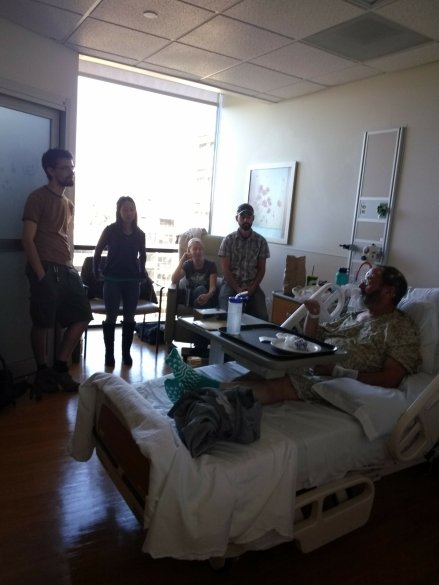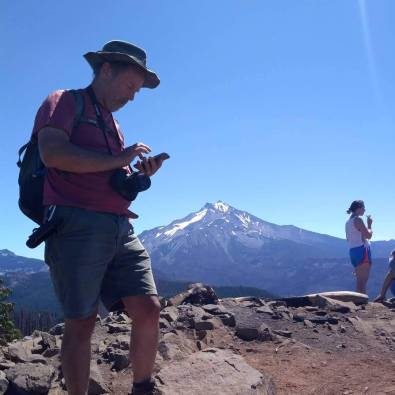One will often have experienced specific symptoms with a diagnosis of glioblastoma, an aggressive form of brain cancer. According to the Mayo Clinic, symptoms typically seen are headache, seizures, and nausea and vomiting. Others include memory loss, decline in brain function, urinary incontinence, personality changes, irritability, and vision issues. Of all the symptoms listed, Bruce had three.
I’m writing this right here, right now, because Bruce wants his story shared.
This fall when I noticed unusual behavior in Bruce, I knew something was very wrong. You can read the first part of our story and Bruce’s atypical symptoms in BRAIN CANCER: ATYPICAL SYMPTOMS, PART I.
What follows is a short timeline of what happened, how I responded, and the outcome. Not only is our story important, a couple of experiences trying to navigate our medical system have left me frustrated and aghast. Something as simple as getting information–or even a consensus–should not be so hard, but I’m getting ahead of myself.
My first recollection of odd behavior was September 8, but by the time September 25 had rolled around, I’d been watching Bruce every moment possible. I took videos, I watched, I asked others, and I took notes.
September 25
Since I was beside myself with worry, I sent our PCP a note, detailing behaviors I had been seeing. Having worked in the medical field for 34 years, I know the value of documentation (and the reason I avoided the phone). Bruce was to see her on the 27th for another matter, so I continued to watch. She discussed with Bruce what I had written; he came home with a “She says I’m fine” message from the doctor. I was pretty upset. She did suggest, however, that we see her together. In hindsight, I realize she knew I would not be put off. By this time, I’d convinced Bruce to let me do all the driving.
October 2
Together we saw our PCP to review my observations. Bruce is a charmer. He jokes with and teases everyone. Since he was seated in a chair when the doctor walked in, she did not see much of what I’d been seeing. She could not tell, for example, how difficult it had become for Bruce to get in and out of the car. She had no way of knowing his judgment was compromised while driving. She did not see how much sleep he now required. He “looked” just fine. Her diagnosis? Sleep apnea.
October 4
I tried to understand the doctor’s reasoning but it simply didn’t ring true. I can’t tell you how badly I wanted her to be right. But, I know this man, and the kids and I could not accept her assessment. What I saw convinced me that something was wrong, that this wasn’t about sleep. I was beside myself over what to do. A friend suggested I take Bruce to an ER where, based on the symptoms, they would perform an MRI.
Thirty six hours later, on the 4th, I sent our PCP another message, describing each and every odd behavior I’d noticed since she’d seen Bruce two days prior.
October 5
Late the previous night, our PCP sent notice she’d ordered the MRI. On the morning of the 5th, a Friday, Bruce and I both received a call from her office letting us know an MRI had been scheduled for October 10th, the following Wednesday.
October 10
After the MRI, Bruce and I were instructed to head over to the PCPs office immediately. I knew right then this was bad; no one needs to go immediately unless it’s bad. We received the diagnosis of glioblastoma multiforme, a grade four, very aggressive brain cancer. Our PCP was out of the office, so we received the news from her associate (my former patient). She left the room several times, to talk with specialists, in order to secure Bruce a spot on the operating table the following Monday. From this moment on, things happened at lightning speed.
We left the PCPs office with a prescription for the steroid Keppra to prevent seizures. We picked up the prescription on our way home. We told our daughter and called our oldest son.
October 12
You may remember reading in Part I that our son flew to Germany on September 8, the day I noticed the first of Bruce’s odd behaviors. This is our middle child and second oldest son, whose birthday is October 12 (his 30th). I had to tell him via email that his father had a brain tumor. We were unable to connect in a private call. I can’t tell you how hard that was, how much that hurt, to tell my child this type of news in this manner, on his birthday. From that moment, he busted his butt to get home to see his father before surgery. One flight was cancelled and another was delayed, but by 3 pm on the 14, Andrew (left), barely vertical from a lack of sleep, walked into Bruce’s hospital room.

October 14, admit day, the afternoon before surgery
October 14
It was suggested that Bruce be admitted on the day before surgery in order to facilitate all that needed to be done; there were blood draws and scans and doctor visits. We agreed since, the next morning on October 15, Bruce would go into surgery at 7:30 am.
Since Bruce would endure yet another major event aside from surgery the next morning, and because it baffled the doctor, I’ll continue in another post.

Hiking Oregon trails, July 2018
Thank you for reading, and blessings to you. ❤

I’ll be catching up after tomorrow. Keeping you in my prayers today. Giant squishy hugs.
LikeLiked by 1 person
You’re the very best. Happy New Year, Marlene. ❤
LikeLiked by 1 person
I am glad you are documenting this story. It is important for all of us.
LikeLiked by 1 person
Thank you. We are happy to share if it helps other people. I’ll plow forward here. ❤
LikeLike
Thank you, and I am trying to keep plowing forward. Bruce wants his story shared. ❤
LikeLike
Thank you for sharing, you’re both in my prayers.
LikeLiked by 1 person
And you are in mine. 🙂
LikeLiked by 1 person